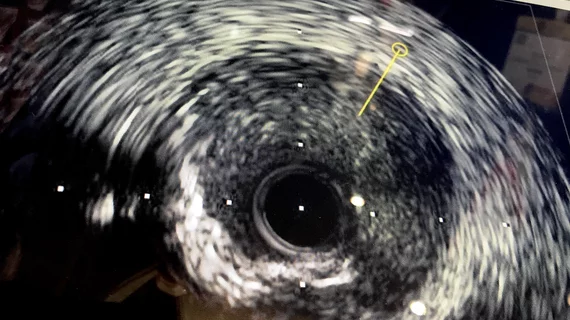Intravascular imaging-guided PCI linked to improved survival, fewer adverse events in large new analysis
Guiding percutaneous coronary intervention (PCI) procedures with intravascular ultrasound (IVUS) or optical coherence tomography (OCT) is associated with significantly better clinical outcomes than using traditional angiography, according to a new meta-analysis published in The Lancet.[1]
The study’s authors tracked data from nearly 16,000 patients who underwent PCI from March 2010 to August 2023. This is believed this to be the largest comparison of intravascular imaging-guided PCI and angiography-guided PCI to date, covering patients treated all over the world as part of 22 different clinical studies. The mean follow-up period was approximately two years.
Compared to angiography-guided PCI, intravascular imaging-guided PCI was associated with substantial reductions in a patient’s risk of cardiac death, target vessel myocardial infarction, any myocardial infarction, target lesion revascularization, stent thrombosis and all-cause mortality. The all-cause mortality risk, for instance, was reduced by 25% when patients were treated with intravascular imaging-guided PCI instead of angiography-guided PCI.
“Prior studies had shown benefits of intravascular imaging, but never to this extent,” first author Gregg W. Stone, MD, director of academic affairs with the Mount Sinai Health System and a professor with the Icahn School of Medicine at Mount Sinai, said in a statement. “The addition of four recent trials in which 7,224 patients were enrolled now shows that intravascular imaging reduces all-cause death and all heart attacks across the wide range of patients who undergo stent treatment. As such, the routine use of intravascular imaging to guide stent implantation is one of the most effective therapies we have to improve the prognosis of patients with coronary artery disease.”
Guidance with IVUS and OCT, the researchers added, were found to be comparable with one another. OCT is associated with images that are higher in quality than IVUS, but OCT utilization remains quite low throughout the United States. Even IVUS utilization is much lower—15% or 20%, according to the authors—than industry experts would like it to be.
“With these results, we now need to shift from performing more studies to determine whether intravascular imaging is beneficial, to increasing efforts to overcome the remaining impediments to the routine use of OCT and IVUS, including better training of physicians and staff and increasing reimbursement,” Stone said. “In this regard, we now have better ‘hard evidence’ that intravascular imaging guidance of PCI procedures makes a greater impact to improving our patients’ lives than other routine therapies which are more widely used and reimbursed.”
Read the team’s full analysis here.
For additional context, read about similar research Stone presented at ESC Congress 2023.

